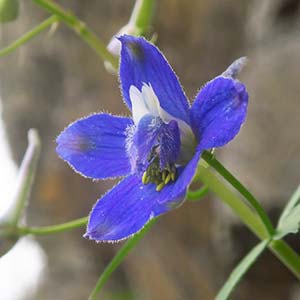Delphinium basalticum
Delphinium sect. Diedropetala
basalt larkspur, basaltic larkspur, Columbia Gorge larkspur
2-80 cm, tuberlike or fibrous, dry or fleshy;
buds often less than 3 mm.
20-50(-65) cm;
base often reddish, puberulent.
1-8(-19) per root;
base firmly attached to root or not.
blade round, 2-6 × 5-9 cm, not succulent, nearly glabrous; ultimate lobes 5-19, width 3-15 mm (basal), 1-12 mm (cauline).
cauline and/or in basal rosette, gradually or abruptly reduced into bracts.
(2-)6-16(-26)-flowered;
pedicel 2-7 cm, nearly glabrous;
bracteoles 4-12 mm from flowers, green, linear, 3-7 mm, nearly glabrous.
sepals dark blue, nearly glabrous, lateral sepals spreading, 15-21 × 7-10 mm, spur straight to decurved, ascending 30-45° above horizontal, 14-18 mm;
lower petal blades slightly elevated, ± exposing stamens, 7-9 mm, cleft 4-5 mm;
hairs centered, mostly on inner lobes above base of cleft, yellow to white.
sepals blue, purple, white, red, or yellow;
lower petal blades often same color as lateral sepals, usually greater than 1/5 length of lateral sepals (exceptions in red- and yellow-flowered species).
12-17 mm, 3.5-4 times longer than wide, glabrous.
± wing-margined;
seed coat cells with surfaces smooth.
Delphinium basalticum
Delphinium sect. Diedropetala
Of conservation concern.
Hybrids between Delphinium basalticum and D. trolliifolium are known.
(Discussion copyrighted by Flora of North America; reprinted with permission.)


